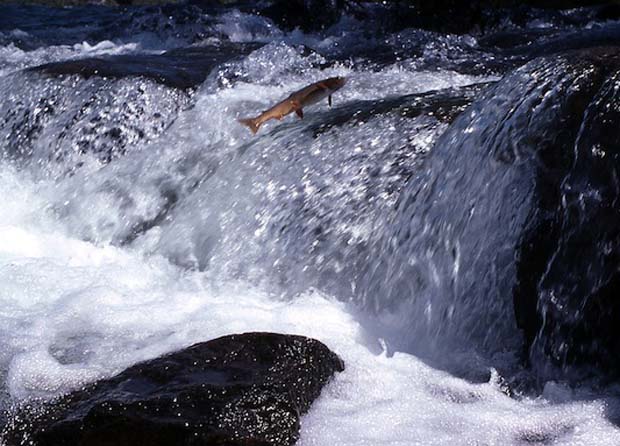Progress Seen In Protecting Yellowstone Cutthroat Trout From Lake Trout In Yellowstone National Park
Submitted by NPT Staff / See previous post on this story . . .

Efforts to rebuild the population of Yellowstone cutthroat trout, such as this one heading upstream at LeHardy Rapids, in Yellowstone Lake are succeeding. NPS-Harlan Kredit
[dropcap]T[/dropcap]wo decades after non-native lake trout were discovered in Yellowstone Lake, officials in Yellowstone National Park say they are making good progress in removing those predacious fish and rebuilding the lake’s iconic Yellowstone cutthroat trout population.
With more than 1 million lake trout removed from the 136-square-mile lake over the years, the National Park Service, Trout Unlimited, local fishing guides and the recreation industry say they have made “significant progress” in efforts to restore the native Yellowstone cutthroat trout in Yellowstone Lake—one of the largest and most ambitious native trout restoration efforts ever undertaken.
The cutthroat trout is an iconic species and treasure of park anglers and wildlife watchers. Spawning each year in the Yellowstone River and more than 60 of the lake’s shallow tributaries, the cutthroat has served a vital role in Yellowstone Lake’s ecosystem as an important food source for grizzly bears, birds of prey and other wildlife. But the much larger, and voracious, lake trout had greatly reduced the cutthroat population and resulted in several of these species having to use alternate food sources during certain times of the year.
The impact on Yellowstone National Park’s ecosystem has been significant—grizzly bears that once depended on cutthroat trout for early season food are now resorting to other sources of protein, like elk and moose calves. Ospreys, which were once prevalent at Yellowstone Lake, have moved on to more productive waters. Additionally, anglers who once lined the banks of the Yellowstone River on opening day are all but gone, thanks to the declining fishery.
For more than eight years, the National Park Service has conducted gill-netting operations and other efforts to reduce lake trout populations and give native Yellowstone cutthroat trout a chance to recover. Those efforts now are paying off: Recent data indicate that culling efforts are working to suppress invasive lake trout and restore the native cutthroat trout fishery.
“The data suggests that we have turned a corner in saving this iconic and globally significant population of native trout,” said Jack Williams, senior scientist for Trout Unlimited, in a press release. “While we have a lot of work left to do, these are very encouraging results.”
According to NPS staff, an analysis of data shows progress on several fronts:
[highlight color=”yellow”]…[/highlight]Annual monitoring suggests an increase in abundance of juvenile cutthroat trout within Yellowstone Lake over the last two years.
[highlight color=”yellow”]…[/highlight]Lake trout suppression efforts, especially in the larger-mesh nets, were significantly increased for a second year in a row (up 70 percent in 2012 over 2011; up 35 percent in 2013 over 2012 for all meshes).
Despite this increased effort in 2013, the number of lake trout caught remained just over 300,000 in both 2012 and 2013, indicating a decrease in overall lake trout numbers. New analyses from Montana State University indicate that suppression efforts have put the lake trout population into a state of “negative growth”—meaning that netting efforts are causing the population to decline.
After reviewing the data, the Yellowstone Science Review Panel last week concluded that the native cutthroat recovery campaign is making “significant progress,” and that Yellowstone National Park should continue culling efforts at present levels.
At the same time, NPS biologists are finding more sophisticated methods of controlling the lake trout population, such as using electricity to destroy lake trout eggs and larvae at spawning grounds—efforts that the independent science panel said show great promise.
“While we likely will never completely rid Yellowstone Lake of this invasive species, recent analyses suggest that, with a sustained effort, we can successfully manage the lake trout population and provide an environment where Yellowstone cutthroat trout can once again thrive in Yellowstone Lake, be a key component of a healthy ecosystem, and a source of recreation for anglers and visitors,” said Dave Hallac, Yellowstone’s chief of resources. “That will be a huge and historic win for conservation.”
Many of the Yellowstone’s most experienced anglers and dedicated conservationists—including longtime guides Craig Mathews, Mike Lawson and Boots Allen—strongly support the Yellowstone cutthroat trout restoration efforts. The campaign is also supported by Trout Unlimited and its 158,000 angling members, the Greater Yellowstone Coalition, the National Park Conservation Association, the Yellowstone Park Foundation and other conservation groups.
“We’ve found that local and visiting anglers want to restore the native trout,” said Dave Sweet, coordinator of TU volunteers for the cutthroat restoration campaign. “Visitors come to our national parks wanting to experience an intact native ecosystem, existing as it has for eons. It’s part of our natural heritage.”
“The Yellowstone native cutthroats are as integral to Yellowstone’s larger ecosystem as bison and grizzlies,” said Jack Williams. “And they’re one of the most significant populations of native trout in the world. If we can’t save them here, in our flagship national park, where can we save them?”






